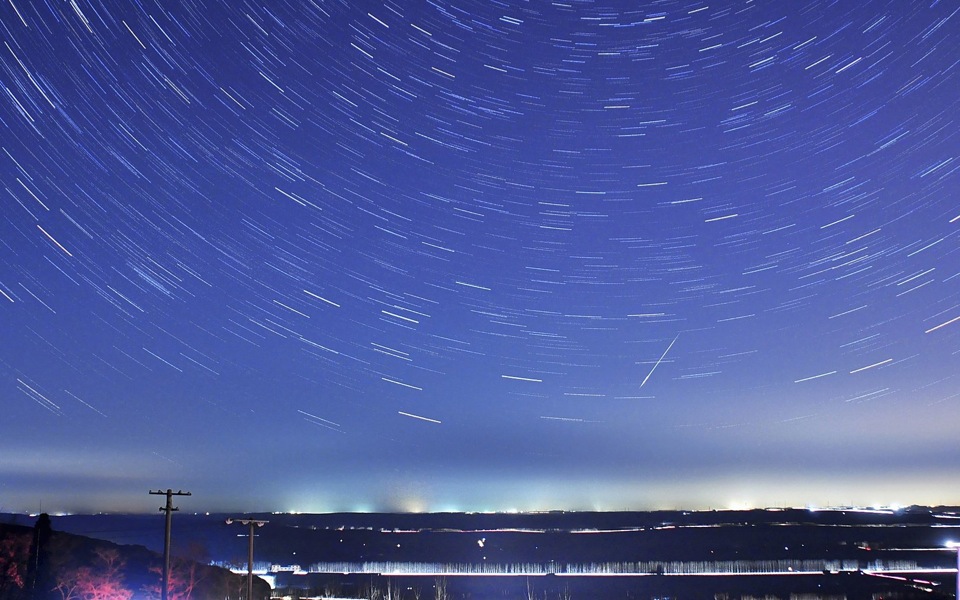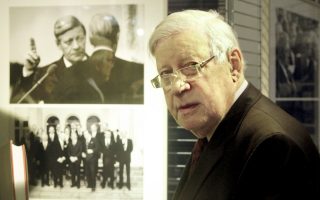The nighttime landscape and the need for a reorientation of public lighting

When, in 1975, Pier Paolo Pasolini remarked, in an article in the Corriere della Sera, that the disappearance of fireflies coincided historically with the disappearance of civilization and the rise of fascism, he sounded, perhaps, as though he was exaggerating, and for some of the more lenient, as if he was probably speaking allegorically. But how allegorical can lighting for cross-examination be considered to be?
Can any form of violence ever be taken to be friendly, or be credited, even, with any other suggestion of good intention?
A negative answer to this rhetorical question was given by their stance some 12 years ago by the local fireflies, as one of the present authors chanced to realize as an eyewitness when he was visiting, yet again, Palaios Panteleimonas in Pieria. There, a few years earlier, the visitor could still have marveled at the reflection of a dense swarm of fireflies in the bushes all around on the sleek paving stones. In the name of the enhancement of the country's mountain regions, the paved footpath had now acquired public lighting.
The megalomania which inspired it was now incompatible with “this little – great – world” in which the spontaneous luminescence of the tiny fireflies, which, following their enforced disappearance from that place, have not since been subsequently replaced by anything of greater cultural importance.
This story is, in spite of its exotic features, entirely representative of the mass market and, consequently, indiscriminate use of the technology of lighting, with a consequence more tragic for human evolution: the biorhythmically fateful dissociation of the manifestations of light from the concept of time, as well as our lately acquired despondency in the face of the hints of night, which in Greece cannot even plead the extenuating circumstance of the timelessness of a white night in distant Helsinki.
Night with us is, then, a synaeresis of a quality of Time and a quality of Light. Erebus and Night were needed, according to Hesiod, for day to result – that is, another pair, of Time and Light, equally by synaeresis. Without Erebus, there is no measure. This alone puts to the test our visual capacity for apprehension by stripping it, pending a revelatory verification of its previously unexpected limits by the misunderstood pirate's blindfold, with which he took care to keep at the ready his ability to see immediately in the dark with his eyes protected from the blinding light, as a more recent finding.
This is how light once made things vanish, however contradictory that may sound. And one wonders at this point about the value of our progress in lighting if we lag behind even the outdated pirate in consciousness of vision.
Is it not light, again, in any event, which does not allow us to see the stars during daytime, and in the times in which we live, in most cities, even at night, because of the advancing light pollution? Is it not this which allows the theoretically evolved child of the city to learn, untouched by nature, by reading in a brightly lit room at night, and the child who lives in the darknesses of the Third World to recognize with ease in the heavenly firmament the constellation of Sirius, unknown to the child of the city?
It could be argued, then, that human vision functions totally disjunctively. It does not have the ability to compare the quality of daylight simultaneously with the quality of semi-darkness. “Darkness occurs in the absence of light,” the “De coloribus” (791a, 1), attributed to Aristotle, notes. This is a recipe for the creation of the quality of light which we call darkness, and which becomes so much more perceptible as light recedes. The receding of light is, in other words, a qualitative and not a quantitative characteristic of it, one, moreover, totally interwoven with the sense of time. In absolute values, the changes in lighting at sunset are no greater than those, equally changing, in the sunlight of noon. However, as the lighting gradually recedes, our own physiological capabilities of sensing more acutely ever smaller differences in lighting which, on the other hand, the magnitude of the scale may render imperceptible, are reinforced. It is precisely this which is the miracle of scale in lighting, which culminates in darkness, in conditions, that is, of our exercise of night vision, rarely activated nowadays, and, for that reason, degenerated, which permits us to perceive with ease as illuminated even the luminance of the dark sky with the moon in its 10th day, that is, a luminance four orders of magnitude (decimal points) lower than that of the road surface of a well-lit avenue at night.
“If we lose darkness, we lose light,” Patricio Hales, UNESCO's emissary to Chile, where astronomy tourism, unknown in Greece, in spite of the favorable climatic conditions, flourishes, thus keeping alive the hope of the survival of the fireflies, as explained in his thesis “Survivance des lucioles” (Minuit, Paris 2009) by the French philosopher Georges Didi-Huberman, pointed out on the occasion of the events marking the World Lighting Year 2015.
In view of the above, it will be easily appreciated that light cannot be understood as an element foreign to the nighttime landscape.
Night has specific visual characteristics, which, moreover, in the past served as a starting point for military planning. In 1938 in Italy, the level of emergency lighting at which airplanes flying at an altitude of 500 meters could not see was 0.01 lx, whereas lighting under normal conditions, before the emergency, was from 0.2 to 0.02 lx, that is, two to three orders of magnitude (decimal points) lower than the level of lighting prevailing today in public space at night. It will be obvious that in the period which has elapsed up to the present, there has been no dramatic anthropological mutation of our visual apprehension, in spite of the fact that this is not precluded in the longue durée if we persist in the use, indiscriminate and asymmetrical with our real needs, of the technological possibilities of lighting at night, included within which is the need for the biorhythmical functioning of our organism, which otherwise will no longer be able to produce the darkness-dwelling and beneficial hormone melatonin, which perhaps explains the 50 percent reduction in the incidence of breast cancer in blind women.
The International Experimental Lighting Seminar, held this year for a second time on Kea, under the auspices of the Metropolitan Bishopric of Syros and with the participation of the Universities of Patras (Greece), Madrid (Spain), Wismar (Germany), and Aalborg (Denmark), yielded new examples of a nighttime landscape, and proved, contrary to the unwitting syndrome of scotophobia, which governs the majority of instances of urban lighting, their visual viability.
Kea was chosen as the venue for the seminar for entirely specific reasons, having to do with the documented high quality of its dark sky. This, on the basis of the relevant measurements, proves to rival the model quality of the night sky in the Atacama Desert in Chile. The resultant interesting finding is attributed to a combination of two favorable factors: on the one hand, the delay in bringing electricity to the island and its underpopulation, which have contributed to a low demand for lighting, and, on the other, the strong winds, which prevent the spread of light pollution from the strongly lit areas of Attica to Kea with the particles in the air as a vehicle, when, in different meteorological conditions, this can happen in the case of much greater distances – up to 300 kilometers – than that from Lavrio to Kea.
This particular environment proved to be ideal for the applications of lighting, based on phosphorescence, in the countryside Chapel of the Archangel Michael at Ioulida, on Kea, since the luminance values of the phosphorescent elements, after many hours of discharge, approach the threshold of the scotopic region on the lower limit of mesopic vision, presupposing the maintenance of a natural nighttime level of lighting. This has been conventionally agreed to approach 0.3 lx, and corresponds to conventionally calculated moonlight.
This precondition was observed in all three experimental lighting projects carried out at Ioulida on 16 October 16, 2015 concerning the nighttime elevation of the Churches of Sts Antony and Menas, of the Holy Trinity, and of the Archangel Michael at Korakogremno. For purposes of the relevant photometric documentation, measurements were taken with a frequency of value measurement of 1 Hz and special equipment capable of measuring accurately even a level of lighting of 50-100 μlx and noise of just 20 μlx at a level of lighting of 1 mlx.
In the neighboring environment of the three churches, that is, at a distance of 2-10 m from their elevation, levels of lighting were measured in the public space of 0.06 lx, 0.08 lx, and 0.02 lx for the Churches of Sts Antony and Menas, of the Holy Trinity, and of the Archangel Michael, respectively. It is worth noting here that these levels are more than four times the level of lighting with a full moon at its zenith and totally comparable with the median value of moonlight in October for the latitude of Kea, which is 41 mlx, and the corresponding mean value for moonlight for Kea in October, which is 57 mlx.
Of particular interest are the experimental applications of night-friendly techniques at the culmination of the efforts to make brighter, on the basis of the physiology of human vision, by artificial means, the darker environment in the area of the Church of the Archangel Michael, which by reason of the relief of Ioulida is favored in this respect, since the distance from the well-lit square, in conjunction with the significant difference in altitude from it and the abundance of narrow paved thoroughfares, which act as traps for artificial light, with the result that along the approach route to the church, values for the level of lighting which approach 1 mlx are encountered – a level which corresponds to a typical value for regions with observatories. The replacement in the more distant environment of the church of every form of artificial light by phosphorescent striations coinciding with the occurrence of the joints in the paving, proves to be an ideal condition for the scanning of the galaxy in the unique sky of Kea.
The International Lighting Seminar on Kea (October 12-16, 2015) produced the above tangible results. It has thus proved, not only experientially, but also scientifically, the pragmatism of the techniques of low lighting, which at the same time constitutes a tool of international range for the promotion of initiatives for the establishment of maximum values for lighting in the public space, as a first step toward the making good of the consequences of public lighting which are injurious to the authenticity of the nighttime landscape.
* Dr Georgios Paissidis is president of the Hellenic Lighting Committee. Dr Gunther Wuchterl is president of the Kuffner Observatory, Vienna.




